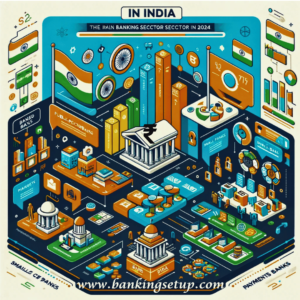Full List of Banks in India (2024 Edition): Public, Private, Small Finance, and Payment Banking Institutions
Embarking on a journey through the diverse and expansive landscape of India’s banking sector, this comprehensive guide serves as your go-to resource for navigating the complex web of financial institutions that form the backbone of the country’s economy. In 2024, India’s banking system, a robust amalgamation of public sector banks, private sector entities, innovative small finance banks, user-centric payment banks, and the ever-essential cooperative banks, presents a fascinating study in financial diversity and accessibility.
At the forefront are the Public Sector Banks (PSBs), characterized by their government ownership and widespread presence. These banks, including stalwarts like State Bank of India and Punjab National Bank, have long been pillars of stability, offering a range of services from retail banking to large-scale corporate finance. They stand as testaments to India’s commitment to financial inclusion and economic growth. Equally pivotal are the Private Sector Banks, such as HDFC Bank and ICICI Bank, which have redefined banking with their customer-centric services, technological innovation, and diverse product offerings, catering to a rapidly modernizing people.
The dynamic landscape of Indian banking is further enriched by Small Finance Banks and Payment Banks, recent entrants that are revolutionizing banking accessibility. These institutions, including names like AU Small Finance Bank and Paytm Payments Bank, are breaking new ground by focusing on underserved segments and leveraging technology to bring banking to every nook and corner of the country. Complementing these are the Cooperative Banks, the bedrock of India’s rural economy, offering a more personalized banking experience, deeply rooted in community values and localized service.
This article provides an exhaustive list and overview of these banking institutions, capturing the essence of each category and offering insights into their operations, services, and unique contributions to India’s economic tapestry. Whether you are an individual seeking personal banking solutions, a business looking for robust financial services, or simply a curious observer of India’s financial landscape, this guide offers a panoramic view of the banking sector, ensuring you are well-equipped to navigate the diverse banking options available in India.

I am providing a comprehensive list of major categories of banks in India, including public sector banks, private sector banks, small finance banks, and payments banks as of the last update in 2023 RBI’s (Reserve Bank of India) official publications or the National Bank for Agriculture and Rural Development (NABARD).
Public Sector Banks (as of 2023)
1. State Bank of India
2. Punjab National Bank
3. Union Bank of India
4. Canara Bank
5. Indian Bank
6. Bank of Baroda
7. Indian Overseas Bank
8. Central Bank of India
9. UCO Bank
10. Bank of Maharashtra
11. Punjab & Sind Bank
Private Sector Banks
- HDFC Bank
- ICICI Bank
- Kotak Mahindra Bank
- Axis Bank
- IndusInd Bank
- Yes Bank
- Federal Bank
- IDFC First Bank
- Bandhan Bank
- RBL Bank
- City Union Bank
- DCB Bank
- South Indian Bank
- Tamilnad Mercantile Bank
- Karnataka Bank
- Karur Vysya Bank
- Jammu & Kashmir Bank
- Nainital Bank
- Lakshmi Vilas Bank
- Dhanlaxmi Bank
Small Finance Banks
- AU Small Finance Bank
- Equitas Small Finance Bank
- Ujjivan Small Finance Bank
- Suryoday Small Finance Bank
- Capital Small Finance Bank
- Fincare Small Finance Bank
- ESAF Small Finance Bank
- North East Small Finance Bank
- Jana Small Finance Bank
- Shivalik Small Finance Bank
Payments Banks
- Airtel Payments Bank
- India Post Payments Bank
- Paytm Payments Bank
- Fino Payments Bank
- NSDL Payments Bank
Co-operative Banks
There are numerous cooperative banks, both urban and rural, across different states in India.
Types of Cooperative Banks in India
State Cooperative Banks (SCBs):
- These operate at the state level and are apex institutions in the cooperative credit structure.
- Each state typically has one State Cooperative Bank.
District Central Cooperative Banks (DCCBs):
- These operate at the district level and form the middle layer in the cooperative credit structure.
- There are several hundred DCCBs across various districts in India.
Urban Cooperative Banks (UCBs):
- These banks primarily operate in urban and semi-urban areas.
- India has over a thousand UCBs, each serving different communities or regions.
Primary Agricultural Credit Societies (PACS):
- These are the grassroots-level cooperative credit institutions in rural areas.
- There are tens of thousands of PACS across India.
Few Notable Cooperative Banks
- Saraswat Cooperative Bank
- Cosmos Cooperative Bank
- Shamrao Vithal Co-operative Bank
- Abhyudaya Co-operative Bank
- Bharat Cooperative Bank
Important Considerations
- Sheer Number: The total number of cooperative banks is vast, and listing them all is beyond the scope of this format.
- Dynamic Sector: The cooperative banking sector is dynamic; banks may merge, and dissolve, or new ones may be established.
- Regional Focus: Many cooperative banks have a strong regional focus, catering to specific local communities.
Frequently Asked Questions (FAQs)
Q1: What are the main types of banks operating in India?
A1: The Indian banking sector comprises several types of institutions, including Public Sector Banks (like State Bank of India), Private Sector Banks (like HDFC Bank), Small Finance Banks (like AU Small Finance Bank), Payments Banks (like Paytm Payments Bank), and Cooperative Banks (like Saraswat Cooperative Bank).
Q2: How do Small Finance Banks differ from other banks in India?
A2: Small Finance Banks in India specialize in providing financial services to underserved sections of society, including small business units, small and marginal farmers, micro and small industries, and unorganized sector entities. They are a key part of financial inclusion in the country.
Q3: Are international banks present in India?
A3: Yes, several international banks operate in India, offering services like corporate banking, investment banking, and wealth management. Prominent examples include Citibank, HSBC, and Standard Chartered.
Q4: What role do Cooperative Banks play in the Indian banking system?
A4: Cooperative Banks in India play a crucial role, especially in rural areas. They cater to the agricultural sector and rural development, providing credit and banking services to farmers and rural communities.
Q5: Can customers access digital banking services with Indian banks?
A5: Yes, most Indian banks, including public and private sector banks, now offer comprehensive digital banking services, enabling customers to conduct various transactions and access services online.
Conclusion
Navigating the vast and varied landscape of the Indian banking sector reveals a rich tapestry of financial institutions, each playing a unique role in fueling the country’s economic engine. From the towering presence of Public and Private Sector Banks, steering the course of mainstream banking, to the niche yet pivotal operations of Small Finance and Payments Banks, the Indian banking scene is a blend of tradition, innovation, and inclusivity. The Cooperative Banks, with their grassroots approach, continue to empower rural segments, maintaining the ethos of community-based banking. Refer more on bankingsetup
This article, enriched with a comprehensive list of these institutions, aims to serve as a valuable resource for individuals and businesses alike, whether for everyday banking needs, specialized financial services, or simply to gain a deeper understanding of India’s banking framework. In a country where economic growth and financial inclusion go hand in hand, these banks collectively contribute to a stronger, more resilient, and inclusive financial future. As India strides forward in the digital era, its banking sector remains a cornerstone, evolving continually to meet the changing needs of its diverse population.





